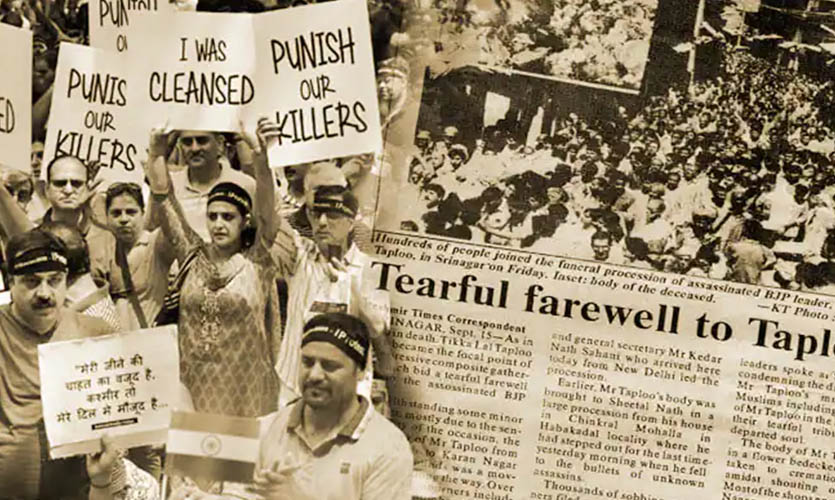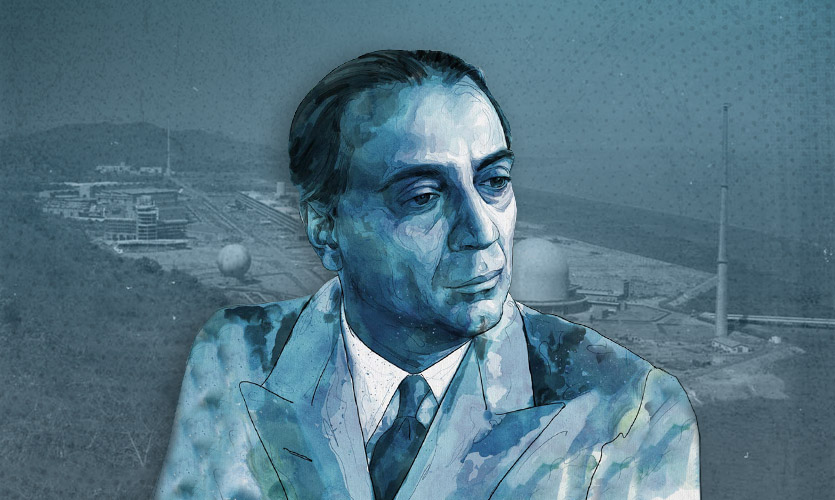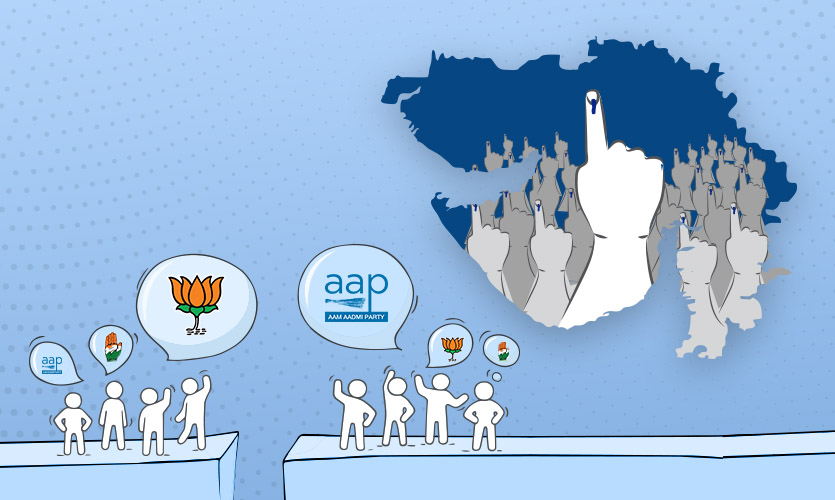“For the illustrious Kashmiri Pandit community, which has contributed a great deal in shaping the nation, building a democratic, progressive and secular India, if the coffers of the country are to be emptied for them, it would still be a small price to pay.”
– Former PM IK Gujral
January 19, observed as ‘Exodus Day’ by Kashmiri Pandits, marks the fateful day when the community was indefinitely exiled en masse out of their homes, in the year 1990.
Mosques across Kashmir Valley echoed with slogans of “raliv, tsaliv, ya galiv” – convert, flee, or die.
Thirty-three years since, as Kashmiri Pandits continue to be refugees in their own country, what are some developments seen in the past year?
The Kashmir Files
It would be remiss to begin with anything but the film that shed light on the plight of Kashmiri Pandits and reignited the need for justice – The Kashmir Files. Taking India by storm after a 32-year long, deafening silence, filmmaker Vivek Agnihotri and lead actor Anupam Kher announced yesterday the Oscar-bound film’s re-release, to run it across several big screens from January 19 until Sunday.
The country has been in an extensive debate of political correctness and blame-game ever since the film first released on March 11 last year, rehashing forgotten history and scraping out old skeletons.
On March 8, 2022, the Bombay High Court had dismissed a public interest litigation (PIL) demanding a stay on the film’s release, filed by one Intezar Hussain Sayed from Uttar Pradesh after the trailer was released. The petitioner had argued, “It is clearly evident that the whole movie will also be portraying in a targeted one-side view of the incident which is not only hurting the religious sentiments of Muslim community but also ignite emotions and inflame the members in Hindu Community with clear possibility of triggering violence (of) immeasurable destruction in all the active parts of India.” Contrary to what the petitioner may have expected, the only deaths caused by the film were those of Kashmiri Pandits still living in the valley, as asserted by People’s Democratic Party head and former Jammu and Kashmir (J&K) chief minister Mehbooba Mufti.
As conversation on the massacre of Kashmiri Pandits garnered attention following the release of the film, on the morning of March 15, 2022, The Quint put up one of its special coverage posts, asking for help in raising Rs 4,32,000 to support their reporting of the Gujarat 2002 riots.
Infamous film and media industry names such as Swara Bhaskar and Rana Ayyub were the obvious opposition against the film, not to mention the fatwā issued against Agnihotri and his wife Pallavi Joshi, the lead antagonist of the film. Israeli filmmaker Nadav Lapid was hailed by many domestic critics for creating a stir at the 53rd International Film Festival of India, by calling the film “vulgar” and “a propaganda”. These events are in addition to what left “academics” like Arundhati Roy have always maintained: “Kashmir has never been an integral part of India.”
The Kashmir Files was welcomed by the governing Bharatiya Janata Party and their supporting act – the Vishva Hindu Parishad (VHP) – and also declared tax-free in several states. However, it was accused that “the movie seeks to divide, polarise and demonise”, making it an “us versus them” exchange yet again. This analysis may stand to reason. But is it the cause or a consequence of the standard already set by the “other” community?
A testimony by Sidhi Raina reads:
“This film shows the horrifying nights not only my family went through but what every Kashmiri Pandit family went through… My father’s sister, Girjia Tickoo, was a librarian at a University who had gone to collect her paycheck, on her way back the bus she was traveling from was stopped and what happened next still leaves me in shivers, tears, and nausea. My bua was then thrown into a taxi, with 5 men (one of them being her colleague), who tortured her, raped her, and then brutally murdered her by cutting her alive with a carpenter saw. Imagine being the brother who had to recognize his Babli, who wasn’t at fault in this gruesome battle of total hypocrisy.”
The character of Sharda Pandit in the film has been based on Sidhi’s aunt Girija Tickoo, and BK Ganjoo’s wife Vijay Ganjoo. The events shown in the film have been confirmed by the kin of both families.
Kusum Kaul, former president of Koshur Samchar, Ahmedabad, shares:
“My uncle was a part of the RSS in Anantnag, and had a meeting with George Fernandes, who was the Union railway minister at the time. Fernandes was in town to find out more about the targeted killings and commission a report, and someone had referred my uncle’s name as he had his ear to the ground.
Next thing we know he is kidnapped, and nobody can find him. I was the one to receive his bullet ridden body, delivered to our doorstep by the JKLF (J&K Liberation Fighters). We had to perform his last rites in a hurry as well so the rest of the family members could make it out safely. My father was already on the hit list stuck outside our house.”
A 1995 report of the International Commission of Jurists has attested: “Until 1990… there was a significant Hindu minority in Kashmir, totalling some 300,000 people. These Hindus (known as Kashmiri Pandits and mainly of the Brahmin caste) were ethnically and linguistically the same as their Muslim neighbours, being descended from those inhabitants who had resisted conversion to Islam.”
If an entire people were allowed to get away with the genocide of a whole other people, is the filmmaker playing the polarising entity by showcasing the same?
For lack of a better phrase, when it comes to The Kashmir Files, a Kashmiri Pandit notes, “Where is the lie?”
No Country For Hindu Justice
The more staunch supporters of the community have come out asking why the Kashmiri Pandits did not take a stand and retaliate. For 32 years, most of the community still recognised their personification with Kashmir Valley – “the cradle of civilisation” – and chose to be civil and put its faith in pursuing justice through democratic means, i.e. the independent judiciary.
On September 2, 2022, the Supreme Court (SC) dismissed a plea seeking an SIT probe into the targeted killing of Kashmiri Pandits during 1989-90. The petitioner NGO ‘We The Citizens’ had sought the declaration of sale of all properties after January 1990 as null and void. The PIL also asked that the Centre and the J&K UT government be directed to conduct a census of Hindu and Sikh victims and survivors of the mass genocide, most of whom are now residing in different parts of India, and their rehabilitation. It sought the formation of an SIT to identify all those who “aided and abetted” in the targeted violence.
“Why should we entertain this? This is purely the domain of the Union government. We are sorry,” said the SC bench of Justices BR Gavai and CT Ravikumar.
On September 19, the Court dismissed a petition seeking a probe into the killing of community leader Pt Tika Lal Taploo in 1989, by JKLF militants. The top court advised the petitioner, the victim’s son Ashutosh, to approach the J&K High Court in Srinagar.
On November 22, 2022, the apex court dismissed a curative petition by NGO ‘Roots in Kashmir’, that sought for an investigation into “the alleged mass murder of Kashmiri Pandits in the valley in 1989-1990”. It also asked for intervention by an independent investigation agency like the CBI as the J&K Police has been unable to make any progress in the hundreds of pending cases. The plea was rejected by a three-judge bench headed by Chief Justice of India DY Chandrachud. The bench, also comprising Justices SK Kaul and Justice S Abdul Nazeer, noted, “In our opinion, no case is made out within the parameters indicated in the decision of this Court in Rupa Ashok Hurra vs Ashok Hurra.” A curative petition is the last legal resort in the apex court, heard only in-chamber unless the possibility of reconsideration of the verdict appears prima facie.
The SC had dismissed the main petition in April 2017, and also the review petition later that year. “No evidence will be available after 27 years. What happened is heart-wrenching but we can’t pass orders now,” observed the Court in 2017. The petition mentioned the SC’s recognition of the Godhra riots and reopening of the anti-Sikh riots’ case after 33 years of the fact, saying that no limitation period was applicable in cases of genocide, ethnic cleansing and crimes against humanity, but made little difference. “No fruitful purpose would emerge, as the evidence is unlikely to be available at this late juncture,” said the Court.
The Honourable Supreme Court got one thing right. It is a late juncture.
Between Death and A Hard Place
Kashmiri Pandits (KP) continue to remain sandwiched between the “so-called national interests” and their own survival. Despite multiple protests and continuous demands by KP employees, the Centre has disallowed their mass transfer or relocation from Kashmir Valley to the Jammu division.
Last year, for the first time in the 32 years since the 1990 exodus, a separate budget was allocated for the return and repatriation of Kashmiri migrants, apart from the existing relief provided. The budgetary allocation effective from March 2022 is Rs 825 crores, 2.5 percent of the allocated budget for the UT. The developments have provided the migrant community with the hope of being reunited with their home – an unfulfilled desire they never had the courage to voice. While it is important to be physically present to make on-ground societal changes and make rightful claims, should it be at the cost of more KP lives?
“Contrary to the claims of the authorities, the ground situation in Kashmir is very grim. The infiltration has neither come down nor have the authorities succeeded to stop the targeted killings,” writes Senior Advocate Ashok Bhan in his column. While attacks on security forces have reduced drastically, Kashmiri Pandits remain “soft targets”, although significantly less vulnerable after the 2003 Nadimarg massacre (the incident detailed at the end of The Kashmir Files).
On April 13, 2022, a fresh letter threatening Kashmiri Pandits to “leave Kashmir or get killed” surfaced in the Veervan Pandit Colony in Baramulla, reportedly “sent by post” by ‘Lashker-e-Islam’. On the same day, another letter was issued by ‘Kashmir Freedom Fighters’ (KFF), a militant group that claimed responsibility for a fatal attack on Dogra Hindu community member Satish Kumar Singh. On May 12, 2022, two months after the release of The Kashmir Files, militants shot Rahul Bhat inside the revenue office – a government institution – where he worked, in Budgam. On August 18, Sunil Kumar was killed and Pitambar Nath Bhat injured while working in an orchard in Shopian’s Chotipora village. On October 15, Puran Krishan Bhat was attacked and killed just outside his home by militant group ‘Kashmir Freedom Fighters’. On January 1 this year, four Hindu civilians were killed after gunmen barged into their houses in Rajouri region and confirmed their identities via Aadhar cards. Two children were killed in an IED blast at one of the houses the next day.
The government has made provisions for housing, employment, and cash assistance according to the policy for Return and Rehabilitation of Kashmiri Migrants to Kashmir Valley, designed under the prime minister’s packages in 2008 and 2015. But the community does not feel safe enough, and government employees, some of whom live in make-shift camps, have been protesting to be reassigned ever since Rahul Bhat’s demise last May. “You have formulated a plan to get young Kashmiri Pandits killed in the name of giving them jobs and rehabilitating them,” said Somnath Bhat, a relative of Rahul.
The grieving protesters were greeted with lathi-charges and tear gas.
The Integrated Future
While recent events seem like Kashmir is still paying its dues, the minority Kashmiri community and the current, non-violent inhabitants of Kashmir Valley appear undeterred in their hopes for a better and developed tomorrow. For the first time post-independence, on January 26 last year, the Indian tricolour was unfurled ceremoniously in Srinagar, atop the clock tower at Lal Chowk.
The delimitation process drew to a close in May 2022, after the Election Commission of India (ECI) implemented the suggested changes, including increasing six assembly constituencies in Jammu region and one in Kashmir, taking the total number of constituencies to 90. Following this, the autonomous body ordered the special summary revision of voters in the UT. The final electoral roll was published on November 25. While hoping for a peaceful, free, and fair election may yet be presumptuous, it would be definite progress. Although the Kashmiri Pandit community is still reeling with recent flashbacks of being treated as an election strategy.
“I think the return of Kashmiri Pandits is being instrumentalised to justify a settler-colonial project in Kashmir,” said Mona Bhan, an associate professor of South Asian Studies at Syracuse University, to the Middle East Eye. The publication said that as per the professor, “There remains a deep anxiety among Kashmiri Pandits that their pain is being weaponised to further the goals of the BJP-led government.”
With regards to international views over Kashmir, there has always been geo-political interference in the name of dialogue, creating pressure on India to back off from an inalienable part of the country, fomented by the begging hands and starving mouths of Pakistan at inappropriate forums.
While Kashmiri Pandits debate whether their cause satisfies only an election agenda, there is little doubt of their compliance as long as they are just as disadvantaged as any other aam aadmi.
Unfortunately, 75 years later still, some Jinnahs remain more equal.
The Horus Eye is a weekly column written by Divya Bhan analysing current affairs and policies. This column does not intend or aim to promote any ideology and does not reflect the official position of The Sparrow.
Also read: Why Does The Ethnic Cleansing Of Kashmiri Pandits Need To Be Recognised As A Genocide?










